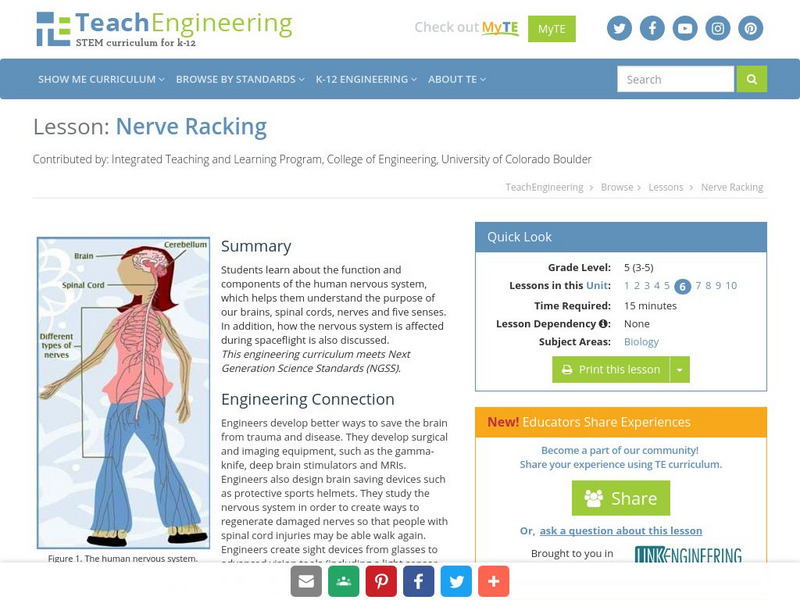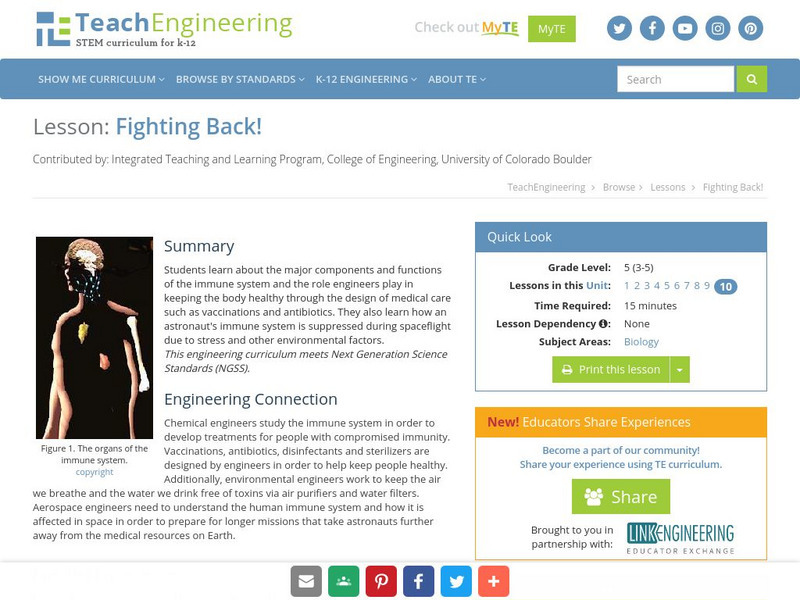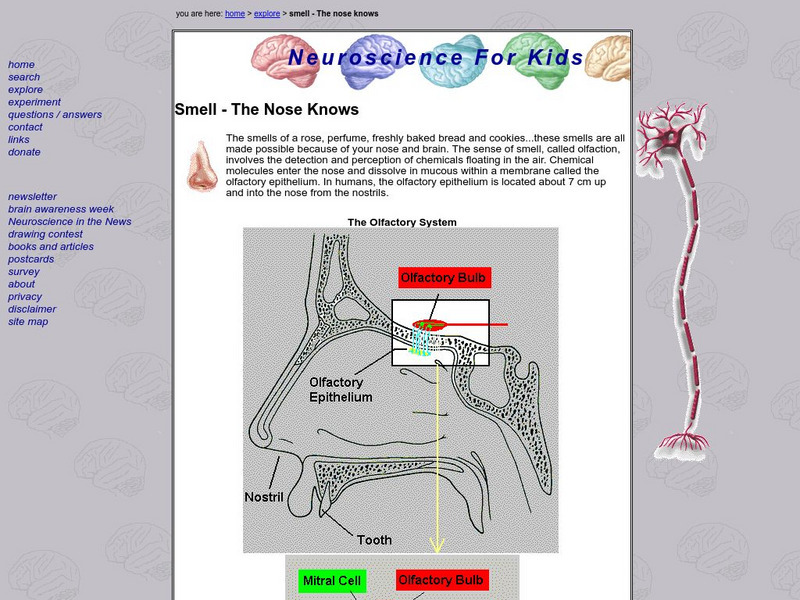TeachEngineering
Teach Engineering: Medical Instrumentation
Young scholars will discuss the special considerations that must be made when dealing with the human body, and will gain an appreciation for the amazing devices that have improved our quality of life. They will also explore how 'Form...
TeachEngineering
Teach Engineering: Kidney Filtering
In this activity, students filter different substances through a plastic window screen, different sized hardware cloth and poultry netting. Their model shows how the thickness of a filter in the kidney is imperative in deciding what will...
TeachEngineering
Teach Engineering: Muscles, Oh My!
Students are introduced to how engineering closely relates to the field of biomechanics and how the muscular system produces human movement. They learn the importance of the muscular system in our daily lives, why it is important to be...
TeachEngineering
Teach Engineering: Body Circulation
Students are introduced to the circulatory system, the heart, and blood flow in the human body. Through guided pre-reading, during-reading and post-reading activities, students learn about the circulatory system's parts, functions and...
TeachEngineering
Teach Engineering: Digestion Simulation
To reinforce students' understanding of the human digestion process, the functions of several stomach and small intestine fluids are analyzed, and the concept of simulation is introduced through a short, introductory demonstration of how...
TeachEngineering
Teach Engineering: Biomedical Devices for the Eyes
Students examine the structure and function of the human eye, learning some amazing features about our eyes, which provide us with sight and an understanding of our surroundings. Students also learn about some common eye problems and the...
TeachEngineering
Teach Engineering: Polluted Air = Polluted Lungs
To gain a better understanding of the roles and functions of components of the human respiratory system and our need for clean air, students construct model lungs that include a diaphragm and chest cavity. They see how air moving in and...
TeachEngineering
Teach Engineering: Breathe In, Breathe Out
Students are introduced to the respiratory system, the lungs and air. They learn about how the lungs and diaphragm work, how air pollution affects lungs and respiratory functions, some widespread respiratory problems, and how engineers...
TeachEngineering
Teach Engineering: Muscles, Muscles Everywhere
This activity helps students learn about the three different types of muscles and how outer space affects astronauts' muscles. They will discover how important it is for astronauts to get adequate exercise both on Earth and in outer...
TeachEngineering
Teach Engineering: Our Amazing Skeleton
This lesson plan covers the topic of human bones and joints. Learners learn about the skeleton, the number of and types of bones in the body, and how outer space affects astronauts' bones. Students also learn how to take care of their...
TeachEngineering
Teach Engineering: Nerve Racking
This lesson describes the function and components of the human nervous system. It helps students understand the purpose of our brain, spinal cord, nerves and the five senses. How the nervous system is affected during spaceflight is also...
TeachEngineering
Teach Engineering: Fighting Back!
This lesson plan describes the major components and functions of the immune system and the role of engineers in keeping the body healthy (e.g., vaccinations and antibiotics, among other things). This lesson plan also discusses how an...
OpenStax
Open Stax: Calcium Interactions of the Skeletal System and Other Organ Systems
This site provides a plethora of information regarding calcium homeostatis and interactions of the skeletal system. Disorders such as hypocalemia and hypercalcemia are discussed.
OpenStax
Open Stax: Pelvic Girdle and Pelvis
The following site helps you understand the pelvic girdle and pelvis.
OpenStax
Open Stax: Muscle Fiber Contraction and Relaxation
This site provides young learners with information regarding muscle fiber contraction and relaxation.
OpenStax
Open Stax: Exercise and Muscle Performance
Physical training alters the appearance of skeletal muscles and can produce changes in muscle performance. Conversely, a lack of use can result in decreased performance and muscle appearance. This site helps students understand exercise...
OpenStax
Open Stax: Muscles of the Pectoral Girdle and Upper Limbs
This site provides interactive information regarding the muscles of the pectoral girdle and upper limbs.
OpenStax
Open Stax: Tissue Injury and Aging
Tissues of all types are vulnerable to injury and, inevitably, aging. Understanding how tissues respond to damage can guide strategies to aid repair. Also understanding the impact of aging can help in the search for ways to diminish its...
OpenStax
Open Stax: Nervous Tissue Mediates Perception and Response
Learn here all about nervous tissue, a tissue that is excitable and capable of sending and receiving electrochemical signals that provide the body with information.
University of Missouri
University of Missouri: Functional Anatomy of the Horse Foot
This effective anatomy lesson presents a detailed description of the horse's hoof with emphasis on the structure and function of the wall, sole, and frog.
University of Washington
University of Washington: Nose Structure and Function
Discusses how the structures of the noseinteract to produce our sense of smell.Has links to lab activities and teacher lessonson this topic.
Alabama Learning Exchange
Alex: The Voice
A lesson that teaches students the anatomy and physiology of the human voice. Students learn how different sounds are made and analyze their voices as well as the voices of several musicians.
Wisc-Online
Wisc Online: Body Terminology Baseball
Answer the anatomy and physiology questions correctly, and score a homerun!
Other
University of Western Australia: Integumentary System
A resource for advanced anatomy and physiology classes. It contains information on the integumentary system, the epidermis, the dermis, hair, sebaceous glands, and sweat glands. Microscopic images are included.
Other popular searches
- Heart Anatomy and Physiology
- Anatomy and Physiology Web
- Plant Anatomy and Physiology
- Basic Anatomy and Physiology























